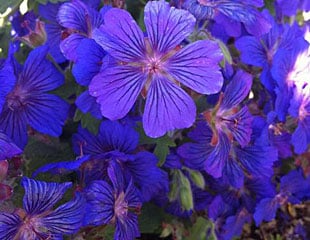
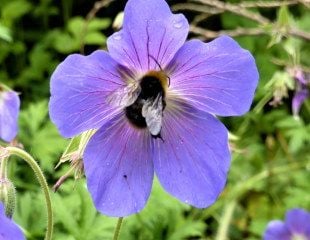
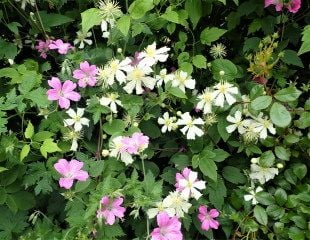
How to Grow Hardy Geraniums
Hardy Geraniums are frost hardy perennial which is easy to grow and suitable for all soil types.
Hardy geraniums are a versatile border plant, long flowering, suitable for most growing conditions, and they mix well with other summer flowering perennials. This group of Geraniums, whose common name is Cranesbill, are fully hardy to H7 which means they will withstand our winters and return reliably in the spring. Many are herbaceous, but not all; some are evergreen and semi evergreen depending on the variety. They should not be confused with Pelargoniums (also often called Geraniums.) which are not hardy and typically used in summer bedding displays.
Geraniums varying significantly in size from Geranium pratense, (herbaceous) the meadow cranesbill, which grows to around 1 meter, to small compact low growing varieties such Geranium sanguineum (herbaceous) which is around 30 cms. The gallery below illustrates around 10 different types of Geranium, the main variation is in size.An added bonus, both bees and butterflies love Geraniums.
Geraniums flower in a range of colours typically blue, purple, pink and white, and often has attractive markings or veins inside the flowers. Some planting ideas are illustrated below. Geraniums look good with Candelabra primula, red Geum, Alchemilla mollis and roses .
Growing geraniums around Alliums is common practice to cover the base leaves of Alliums, which can look untidy, even early in the season.
Some Geraniums are long flowering and will flower right from June to frosts. This type of Geranium will come back year after year, although the herbaceous varieties will disappear over winter and regrow in the spring.
If Geraniums are not the garden plant for you, for more ideas check out summer flowering plants spring flowering plants 20 Best scented plants and climbing plants for more inspiring ideas.
Where to plant Hardy Geraniums
Geraniums will grow in sun or partial/light shade and will grow in all soils except wet or boggy sites. Growing Geraniums is easy, and I classify them as "green wheelbarrow", one of the easiest of plants to grow. Geraniums are undemanding, will return and flower each year and do not need feeding.
There are also a number of geraniums which will grow in shade. One of the most well known is G. Rozanne which flowers well in part shade, and will flower in full shade but inevitably it will have fewer flowers but makes good ground cover for a tricky area.Geranium x ‘Wargrave Pink’ a delicate pink variety is shade tolerant as is G. ‘Anne Thomson’ a low growing purple variety.
In terms of maintenance, to keep Geraniums flowering they are best dead-headed, which can be time-consuming as they may have dozens of spent flowers, more details below.
Planting combinations with Geraniums
Geraniums are versatile and look good planted with many of our garden favourites. Illustrated below are four planting combinations. In addition Geraniums look good planted with Nepeta, low growing roses, Achillea, Salvia, and many summer flowering perennials.
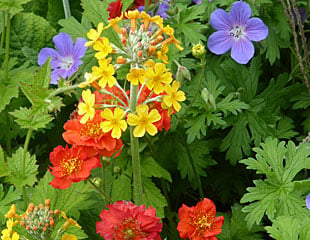
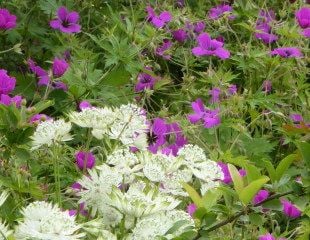
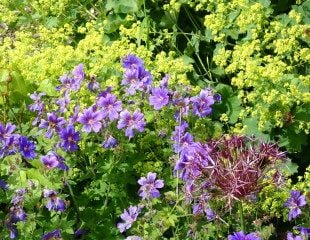

Bee Friendly Geraniums
Many Geraniums flower in shades of blue and purple, which makes Geraniums are attractive to bees. If you are interested in seeing just how attracted bees are to blue Geraniums, take time out to view a short video taken on a lovely warm summer's day. If nothing else, it's a relaxing few minutes with the sounds of summer. In this setting, Geraniums and Chives are planted together to create a bee heaven.
Dead heading and Cutting back Hardy Geraniums
One of the good things about Growing Geraniums is that they need little attention and they will grow in most soils, (except waterlogged,) in full sun or in partial shade. The only effort when growing Geraniums is regarding dead heading and because most varieties of Geranium produce a lot of flowers, this equates to a lot of dead heading.
Dead heading can be time consuming, and there are two ways of tackling this. One way is to dead head each flower individually, which may be practical at the beginning of the summer, but as more and more flowers appear and die on the plant, it can become too time consuming.
The image below shows the very large number of spent flowers some Geraniums can produce dead headed in one session.
The alternative, which is helpful when the foliage becomes tired looking later in the summer, is to cut the plant right back during the summer after it's had a good spell of flowering. It will quickly re grow and produce new green foliage and usually a further flush flowers. If you don't want to look at the bare earth whilst waiting for it to grow back, you can always prune it before you go on holiday and when you come back, there will be a neat green mound of new foliage.
In the images below, I cut the Geranium cut back on 25th June. As the image shows, the plant has become a bit leggy with lots of flowers.I took the next image on 26th July by which time the plant has grown back and started flowering again.
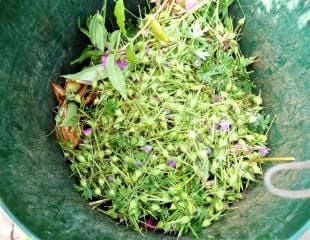
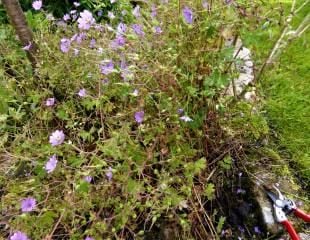
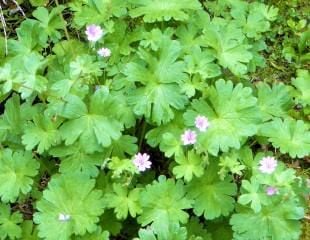
A gallery of Hardy Geraniums to grow
There are many geraniums to choose from in all shades of pink, blue, white and all are easy to grow.
In addition to those illustrated, G. Blue cloud has the AGM award and is a lovely soft blue growing to around 30cms and will grow in sun and partial shade. G. Rozanne 'Gerwat' has the AGM is similar but with a white centre.
A good white variety with the AGM award is G. macrorrhizum 'White-Ness' which forms a carpet of low growing white flowers
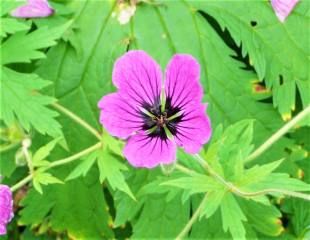
This Geranium Patricia ('Brempat') has bright magenta coloured flowers with black veins. Long flowering and low growing, it prefers a sunny position but will tolerate partial shade fully hardy.
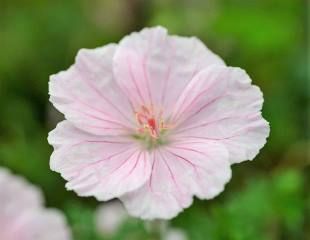
Geranium sanguineum. var. striatum AGM is a lovely low growing up to 30cms and pale pink variety which has a compact shape, and long flowering. Ideal in a sunny spot at the front of a border.

Geranium Sabani blue has one of the boldest blues of the Geranium family. It will grow up to around 40cms flowering early in the year around April time.
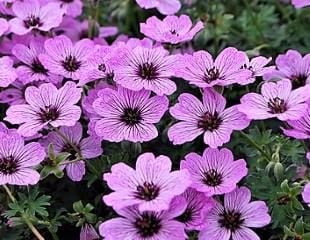
Geranium pratense, which grows up to around 1 meter, flowering from early summer onward, it is deciduous and tolerant of partial shade.
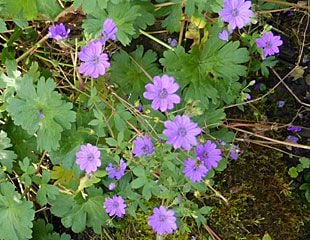
Many Geraniums are long flowering. This final illustration is Geranium pyrenaicum, common name Hedgerow Geranium. It is classified by many as a wild flower, although commercially available. Lovely, upright in growth to around 45-60cms delicate flowers which appear to have 10 petal and lovely pale lilac. It has a sprawling habit but still appears neat and flowers for months and months.
The image left was taken in November during a mild autumn, and still flowering well. This variety is perennial and very similar to Geranium molle, common name Dovesfoot Geranium one of the main differences being the Hedgerow is perennial so much more useful as a garden plant than the annual variety and it is taller.
